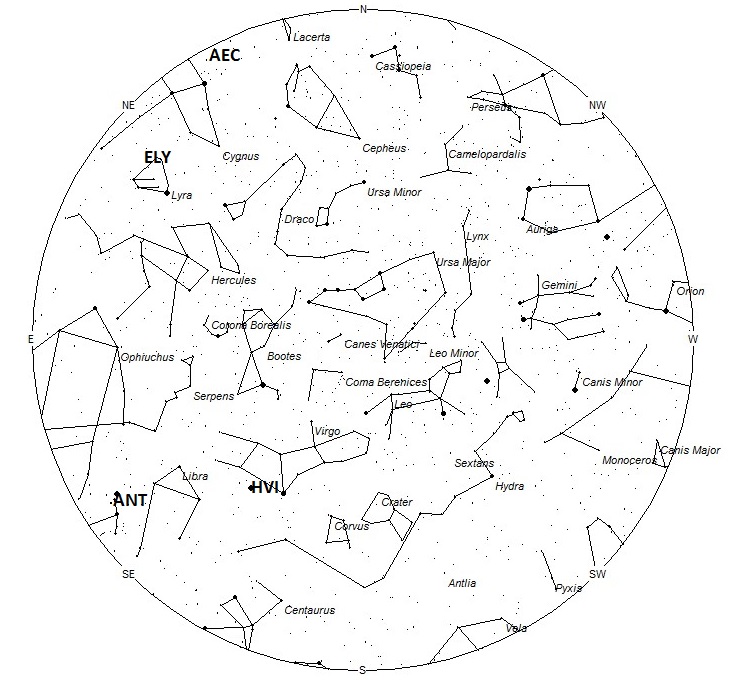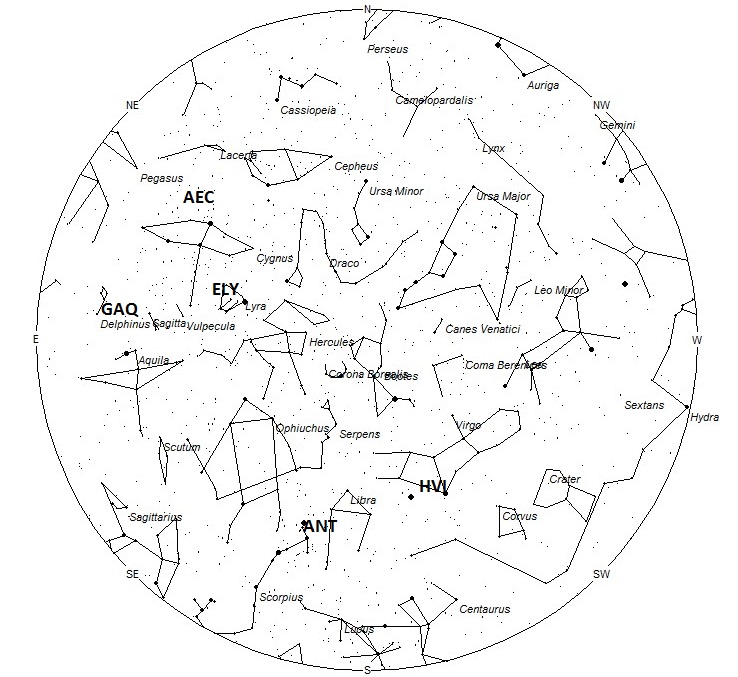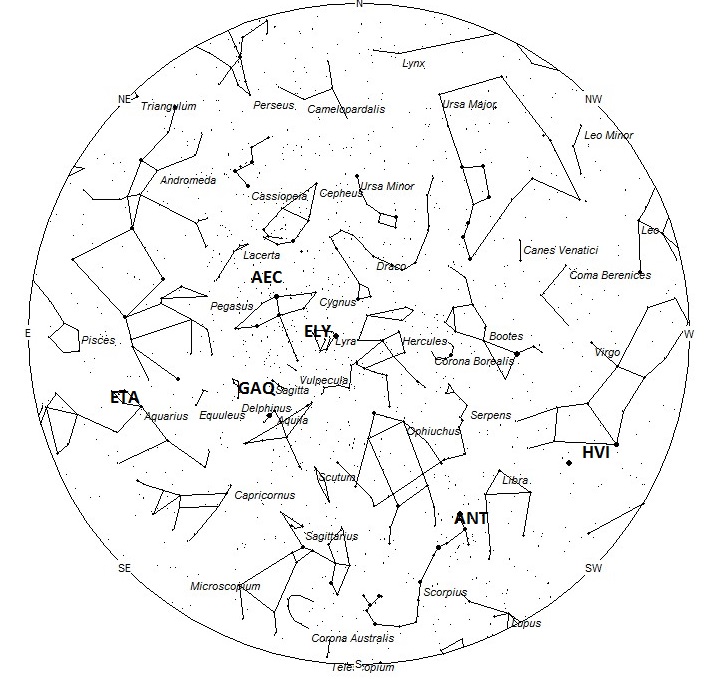May is a fairly slow month for meteor activity. The Eta Aquariids are very active the first two weeks of the month then fade as the month progresses. Unfortunately the nearly full moon will spoil the maximum of the Eta Aquariids this year. The only other showers of note this month are the Eta Lyrids and the Anthelion radiant. These will add only 2-3 meteors per hour to the total count. Sporadic rates are low but steady as seen from the mid-northern hemisphere (45 N). Sporadic rates seen from the tropical southern latitudes (25 S) are strong and remain so the entire month.
During this period the moon reaches its full phase on Sunday May 3rd. At this time the moon will be located opposite the sun and will lie above the horizon most of the night. The estimated total hourly meteor rates for evening observers this week is near 2 for observers situated at mid-northern latitudes and 3 for observers viewing from the southern tropics (latitude 25 S.). For morning observers the estimated total hourly rates should be near 6 for observers situated at mid-northern latitudes and 13 for observers viewing from the southern tropics. The actual rates will also depend on factors such as personal light and motion perception, local weather conditions, alertness and experience in watching meteor activity. Rates during this period are reduced due to intense moonlight. Note that the hourly rates listed below are estimates as viewed from dark sky sites away from urban light sources. Observers viewing from urban areas will see less activity as only the brightest meteors will be visible from such locations.
The radiant (the area of the sky where meteors appear to shoot from) positions and rates listed below are exact for Saturday night/Sunday morning May 2/3. These positions do not change greatly day to day so the listed coordinates may be used during this entire period. Most star atlases (available at science stores and planetariums) will provide maps with grid lines of the celestial coordinates so that you may find out exactly where these positions are located in the sky. A planisphere or computer planetarium program is also useful in showing the sky at any time of night on any date of the year. Activity from each radiant is best seen when it is positioned highest in the sky, either due north or south along the meridian, depending on your latitude. It must be remembered that meteor activity is rarely seen at the radiant position. Rather they shoot outwards from the radiant so it is best to center your field of view so that the radiant lies at the edge and not the center. Viewing there will allow you to easily trace the path of each meteor back to the radiant (if it is a shower member) or in another direction if it is a sporadic. Meteor activity is not seen from radiants that are located below the horizon. The positions below are listed in a west to east manner in order of right ascension (celestial longitude). The positions listed first are located further west therefore are accessible earlier in the night while those listed further down the list rise later in the night.
The list below offers the information from above in tabular form. Rates and positions are exact for Saturday night/Sunday morning.
| SHOWER | DATE OF MAXIMUM ACTIVITY | CELESTIAL POSITION | ENTRY VELOCITY | CULMINATION | HOURLY RATE | CLASS |
| RA (RA in Deg.) DEC | Km/Sec | Local Daylight Saving Time | North-South | |||
| H Virginids (HVI) | May 01 | 13:44 (206) -10 | 17 | 23:00 | <1 – <1 | IV |
| Anthelions (ANT) | – | 15:44 (236) -20 | 30 | 01:00 | 1 – 2 | II |
| Eta Lyrids (ELY) | May 10 | 19:20 (290) +39 | 43 | 05:00 | <1 – <1 | II |
| Gamma Aquilids (GAQ) | May 08 | 20:28 (307) +14 | 66 | 06:00 | <1 – <1 | IV |
| April Rho Cygnids (AEC) | Apr 23 | 21:28 (322) +48 | 42 | 07:00 | <1 – <1 | IV |
| Eta Aquariids (ETA) | May 07 | 22:24 (336) -02 | 67 | 08:00 | 2 – 5 | I |
 American Meteor Society
American Meteor Society



Saw what looked like a shooting star. Amazing!! At first I thought it was a plane, but then it seperated into pieces and became bright before disappearing.
It was near Hackensack/Paramus, NJ area
5/3/2015 at about 10pm – Trained, GA/IFR pilot – looking straight up over N. Virginia home and noticed what looked like any other star in Leo Minor region moving slowly between the stars. Commonly see airplanes taking off from Washington Reagan and landing at Dulles. I know the lighting to expect.
I live in La Pine OR. Was sitting in Living room around 9 pm when I seen a white shooting star that had green and blue around it as it was falling South East. It was very large and very clear. NO I didn’t have my phone handy as it was on charger and no I didn’t make a wish because I was in AWE of how big and clear it was even on a full moon.
Maybe it was a fire ball? BUT It was WHITE – pure white and HUGE with small tail behind it.
I am truly pleased to read this webpage posts which consists of plenty of helpful facts, thanks for providing such statistics.